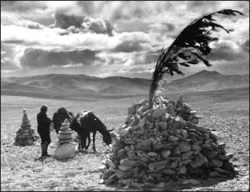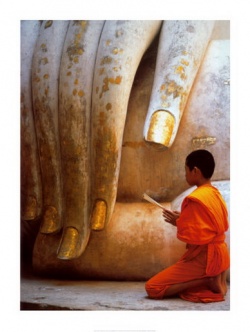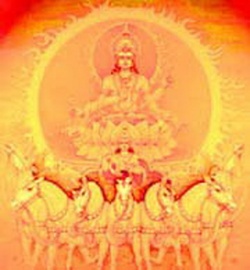Difference between revisions of "Japanese Buddhist Rites"
(Created page with " <poem> Many Buddhist sects in Japan possess their own {{Wiki|distinctive}} rites. The rites can be divided into two main categories: those which [[religious]...") |
|||
| Line 1: | Line 1: | ||
| − | + | {{DisplayImages|3351|2499|1896}} | |
<poem> | <poem> | ||
Many [[Buddhist]] sects in [[Japan]] possess their own {{Wiki|distinctive}} [[rites]]. The [[rites]] can be divided into two main categories: those which [[religious]] practitioners perform among themselves and those conducted on behalf of the laity. | Many [[Buddhist]] sects in [[Japan]] possess their own {{Wiki|distinctive}} [[rites]]. The [[rites]] can be divided into two main categories: those which [[religious]] practitioners perform among themselves and those conducted on behalf of the laity. | ||
| − | The first category may be subdivided into [[rites]] conducted with the aim of developing and deepening personal [[religious]] [[faith]], such as [[offerings]] and daily {{Wiki|recitation}} of [[sutras]] or [[mantras]], and [[rites]] centering on [[devotion]] toward [[Buddhas]], [[patriarchs]], and sect founders. The latter include the services for [[Shaka | + | The first category may be subdivided into [[rites]] conducted with the aim of developing and deepening personal [[religious]] [[faith]], such as [[offerings]] and daily {{Wiki|recitation}} of [[sutras]] or [[mantras]], and [[rites]] centering on [[devotion]] toward [[Buddhas]], [[patriarchs]], and sect founders. The latter include the services for [[Shaka Kōtan'e]] ([[Buddha's birthday]]) on April 8 and [[Nehan'e]] ([[Feast of the Buddha's Entry into Nirvana]]) on February 15, as well as the various memorial services conducted for the founders of particular sects, such as [[Daishiko]] on November 23 (for the founders of the [[Shingon]] sect and the [[Tendai]] sect) and [[Hōonkō]] ([[報恩講]]) for [[Shinran]] ([[親鸞]], 1173-1263), the founder of [[Jōdo Shinshū]] ([[浄土真宗]]), celebrated on November 28 in the [[temple]] of [[Higashi Honganji]] and January 16 in [[Nishi Honganji]]. |
[[Rites]] conducted for the laity may also be subdivided into [[rites]] beseeching the [[protection]] of [[Buddhas]], [[bodhisattvas]], and [[heavenly beings]] for the sake of national {{Wiki|security}} or the good [[fortune]] of groups or {{Wiki|individuals}} and [[rites]] for the deceased. All categories of [[rites]] are carried out at [[temples]] and [[monasteries]] with no [[sense]] of {{Wiki|contradiction}} between those intended for [[monastic]] and those intended for lay purposes. There are, however, differences among [[temples]] as to which type of [[rite]] is given more emphasis. One [[temple]] may {{Wiki|emphasize}} services for the [[monks]]' [[spiritual]] exercise, and another may [[stress]] [[rites]] of supplication for the laity. Since the {{Wiki|Edo Period}} (1600-1868) the majority of [[temples]] in [[Japan]] have emphasized [[funeral]] and memorial services, a tendency which derived from the way in which [[Buddhism]] was established in [[Japan]]. | [[Rites]] conducted for the laity may also be subdivided into [[rites]] beseeching the [[protection]] of [[Buddhas]], [[bodhisattvas]], and [[heavenly beings]] for the sake of national {{Wiki|security}} or the good [[fortune]] of groups or {{Wiki|individuals}} and [[rites]] for the deceased. All categories of [[rites]] are carried out at [[temples]] and [[monasteries]] with no [[sense]] of {{Wiki|contradiction}} between those intended for [[monastic]] and those intended for lay purposes. There are, however, differences among [[temples]] as to which type of [[rite]] is given more emphasis. One [[temple]] may {{Wiki|emphasize}} services for the [[monks]]' [[spiritual]] exercise, and another may [[stress]] [[rites]] of supplication for the laity. Since the {{Wiki|Edo Period}} (1600-1868) the majority of [[temples]] in [[Japan]] have emphasized [[funeral]] and memorial services, a tendency which derived from the way in which [[Buddhism]] was established in [[Japan]]. | ||
| − | Officially introduced to [[Japan]] in the middle of the 6th century, it was not until the | + | Officially introduced to [[Japan]] in the middle of the 6th century, it was not until the ppMuromachi Period[[ (1333-1568) that [[Buddhism]] became established among the common [[people]]. In order to achieve this end, [[Buddhism]] had to answer the immediate needs of the [[people]], and one of the ways it did so was by assuming {{Wiki|responsibility}} for [[funeral]] [[rites]]. The indigenous [[religious]] [[tradition]] of [[Shintō]] tended to look with loathing upon [[death]], which was regarded as a source of [[ritual]] [[impurity]] ([[穢れ]] or [[汚れ]] [[kegare]]). [[Buddhism]] responded to the needs of the [[people]] by easing their {{Wiki|fear}} of [[death]], purifying death's [[defilement]], and performing [[rites]] to {{Wiki|comfort}} the restless departed [[spirit]]. [[Buddhist]] [[temples]] increasingly emphasized [[funeral]] [[rites]] and memorial services. The policies of the {{Wiki|Tokugawa}} {{Wiki|shogunate}} mandating [[universal]] registration at [[Buddhist]] [[temples]] also served to institutionalize this specialty of [[funerals]] and memorial services, and these remain the major {{Wiki|social}} functions of [[temples]] today. However, in adapting to [[Japanese]] {{Wiki|culture}}, [[Buddhism]] was considerably affected by native {{Wiki|ancestor}} {{Wiki|worship}} and agricultural [[rites]], resulting in the [[religious]] [[syncretism]] evident in almost all [[Japanese]] [[rites]] and {{Wiki|festivals}} today. |
Annual [[rites]] include the following. | Annual [[rites]] include the following. | ||
| − | Shushoe (修正会): [[rites]] carried out at the New Year, including supplications for [[peace]] for the {{Wiki|nation}}, and {{Wiki|prosperity}} for the [[people]]. | + | [[Shushoe]] ([[修正会]]): [[rites]] carried out at the New Year, including supplications for [[peace]] for the {{Wiki|nation}}, and {{Wiki|prosperity}} for the [[people]]. |
| − | Nehane (涅槃会): [[rites]] performed on February 15 in commemoration of the [[Buddha's]] [[death]] and entry into [[parinirvana]] or complete [[extinction]]. | + | [[Nehane]] ([[涅槃会]]): [[rites]] performed on February 15 in commemoration of the [[Buddha's]] [[death]] and entry into [[parinirvana]] or complete [[extinction]]. |
| − | Higane (彼岸会): [[rites]] conducted on the three days before and after the spring and autumn {{Wiki|equinoxes}}, amounting to approximately one week each. The original purpose was [[attaining]] the Way of the [[Buddha]]; the [[word]] [[higan]] means the other shore or the [[Pure Land]], and the {{Wiki|recitation}} of the [[nembutsu]] and [[pilgrimages]] were major features. [[Activities]] on [[Higan]] today, however, tend to center on visits to the graves of departed family members to conduct memorial services. Shushoe and Higan'e are [[Buddhist]] [[rites]] unique to [[Japan]]. | + | [[Higane]] ([[彼岸会]]): [[rites]] conducted on the three days before and after the spring and autumn {{Wiki|equinoxes}}, amounting to approximately one week each. The original purpose was [[attaining]] the Way of the [[Buddha]]; the [[word]] [[higan]] means the other shore or the [[Pure Land]], and the {{Wiki|recitation}} of the [[nembutsu]] and [[pilgrimages]] were major features. [[Activities]] on [[Higan]] today, however, tend to center on visits to the graves of departed family members to conduct memorial services. [[Shushoe]] and [[Higan'e]] are [[Buddhist]] [[rites]] unique to [[Japan]]. |
| − | [[Shaka]] | + | [[Shaka Kotane]] or [[Busshoe]] ([[仏生会]], [[Buddha's birthday]]), also known as [[Kambutsue]] ([[灌仏会]], [[rite]] of bathing the [[Buddha]]) and popularly as [[Hana matsuri]] ([[Flower Festival]]): the main practice of this occasion (April 8) consists in sprinkling a figure of the {{Wiki|infant}} [[Buddha]] with [[sweet]] tea. |
| − | Urabone (盂蘭盆会, [[Sanskrit]]: [[Ullambana]]), conducted July 13-16 (August 15-16 in some localities ocalities): the [[souls]] of deceased family members are believed to return to the home during this period, and family members perform [[rites]] to greet them. It is also known as Obon (お盆) or just [[Bon]] (盆) {{Wiki|festival}}. | + | [[Urabone]] ([[盂蘭盆会]], [[Sanskrit]]: [[Ullambana]]), conducted July 13-16 (August 15-16 in some localities ocalities): the [[souls]] of deceased family members are believed to return to the home during this period, and family members perform [[rites]] to greet them. It is also known as [[Obon]] ([[お盆]]) or just [[Bon]] ([[盆]]) {{Wiki|festival}}. |
| − | [[Jodoe]] (成道会, feast commemorating the [[attainment of Buddhahood]]): {{Wiki|ceremonies}} take place on December 8, the day when [[Sakyamuni]] is said to have attained [[perfect enlightenment]]. | + | [[Jodoe]] ([[成道会]], feast commemorating the [[attainment of Buddhahood]]): {{Wiki|ceremonies}} take place on December 8, the day when [[Sakyamuni]] is said to have attained [[perfect enlightenment]]. |
Occasional [[rites]] include the following. | Occasional [[rites]] include the following. | ||
| − | Tokudo-shiki (得度式): the [[word]] [[tokudo]] originally had the [[religious]] meaning of "crossing to the other shore," or [[attaining]] [[enlightenment]]. In actual practice it refers to the [[ordination]] {{Wiki|ceremony}} in which a lay [[person]] has his or her head shaved, receives the [[Buddhist]] [[Wikipedia:Habit (psychology)|habit]] and [[precepts]], and becomes a [[monk]] or [[nun]]. | + | [[Tokudo-shiki]] ([[得度式]]): the [[word]] [[tokudo]] originally had the [[religious]] meaning of "[[crossing to the other shore]]," or [[attaining]] [[enlightenment]]. In actual practice it refers to the [[ordination]] {{Wiki|ceremony}} in which a lay [[person]] has his or her head shaved, receives the [[Buddhist]] [[Wikipedia:Habit (psychology)|habit]] and [[precepts]], and becomes a [[monk]] or [[nun]]. |
| − | [[Goma]] ([[護摩]], burning; [[Sanskrit]]: [[Homa]]): a {{Wiki|ceremony}} practiced in [[esoteric Buddhism]]. [[Fire]], as a [[symbol]] of the [[Buddha's | + | [[Goma]] ([[護摩]], burning; [[Sanskrit]]: [[Homa]]): a {{Wiki|ceremony}} practiced in [[esoteric Buddhism]]. [[Fire]], as a [[symbol]] of the [[Buddha's wisdom]], bums away [[illusion]] and [[defilement]], thereby effecting a [[symbolic]] union between the [[Buddha]] and the [[practitioner]]. |
| − | Kanjō ([[灌頂]], [[Sanskrit]]: | + | [[Kanjō]] ([[灌頂]], [[Sanskrit]]: [[Abhiṣeka]]): one of the most important [[esoteric rites]] of the [[Shingon]] sect, representing the [[transmission]] of the secret [[truth]] and conferral of {{Wiki|status}}. [[Water]], representing [[Buddha's wisdom]], is poured on the head of the [[monk]] to [[symbolize]] the [[transmission]] of [[Buddhahood]]. |
</poem> | </poem> | ||
{{R}} | {{R}} | ||
Latest revision as of 07:33, 11 February 2014
Many Buddhist sects in Japan possess their own distinctive rites. The rites can be divided into two main categories: those which religious practitioners perform among themselves and those conducted on behalf of the laity.
The first category may be subdivided into rites conducted with the aim of developing and deepening personal religious faith, such as offerings and daily recitation of sutras or mantras, and rites centering on devotion toward Buddhas, patriarchs, and sect founders. The latter include the services for Shaka Kōtan'e (Buddha's birthday) on April 8 and Nehan'e (Feast of the Buddha's Entry into Nirvana) on February 15, as well as the various memorial services conducted for the founders of particular sects, such as Daishiko on November 23 (for the founders of the Shingon sect and the Tendai sect) and Hōonkō (報恩講) for Shinran (親鸞, 1173-1263), the founder of Jōdo Shinshū (浄土真宗), celebrated on November 28 in the temple of Higashi Honganji and January 16 in Nishi Honganji.
Rites conducted for the laity may also be subdivided into rites beseeching the protection of Buddhas, bodhisattvas, and heavenly beings for the sake of national security or the good fortune of groups or individuals and rites for the deceased. All categories of rites are carried out at temples and monasteries with no sense of contradiction between those intended for monastic and those intended for lay purposes. There are, however, differences among temples as to which type of rite is given more emphasis. One temple may emphasize services for the monks' spiritual exercise, and another may stress rites of supplication for the laity. Since the Edo Period (1600-1868) the majority of temples in Japan have emphasized funeral and memorial services, a tendency which derived from the way in which Buddhism was established in Japan.
Officially introduced to Japan in the middle of the 6th century, it was not until the ppMuromachi Period[[ (1333-1568) that Buddhism became established among the common people. In order to achieve this end, Buddhism had to answer the immediate needs of the people, and one of the ways it did so was by assuming responsibility for funeral rites. The indigenous religious tradition of Shintō tended to look with loathing upon death, which was regarded as a source of ritual impurity (穢れ or 汚れ kegare). Buddhism responded to the needs of the people by easing their fear of death, purifying death's defilement, and performing rites to comfort the restless departed spirit. Buddhist temples increasingly emphasized funeral rites and memorial services. The policies of the Tokugawa shogunate mandating universal registration at Buddhist temples also served to institutionalize this specialty of funerals and memorial services, and these remain the major social functions of temples today. However, in adapting to Japanese culture, Buddhism was considerably affected by native ancestor worship and agricultural rites, resulting in the religious syncretism evident in almost all Japanese rites and festivals today.
Annual rites include the following.
Shushoe (修正会): rites carried out at the New Year, including supplications for peace for the nation, and prosperity for the people.
Nehane (涅槃会): rites performed on February 15 in commemoration of the Buddha's death and entry into parinirvana or complete extinction.
Higane (彼岸会): rites conducted on the three days before and after the spring and autumn equinoxes, amounting to approximately one week each. The original purpose was attaining the Way of the Buddha; the word higan means the other shore or the Pure Land, and the recitation of the nembutsu and pilgrimages were major features. Activities on Higan today, however, tend to center on visits to the graves of departed family members to conduct memorial services. Shushoe and Higan'e are Buddhist rites unique to Japan.
Shaka Kotane or Busshoe (仏生会, Buddha's birthday), also known as Kambutsue (灌仏会, rite of bathing the Buddha) and popularly as Hana matsuri (Flower Festival): the main practice of this occasion (April 8) consists in sprinkling a figure of the infant Buddha with sweet tea.
Urabone (盂蘭盆会, Sanskrit: Ullambana), conducted July 13-16 (August 15-16 in some localities ocalities): the souls of deceased family members are believed to return to the home during this period, and family members perform rites to greet them. It is also known as Obon (お盆) or just Bon (盆) festival.
Jodoe (成道会, feast commemorating the attainment of Buddhahood): ceremonies take place on December 8, the day when Sakyamuni is said to have attained perfect enlightenment.
Occasional rites include the following.
Tokudo-shiki (得度式): the word tokudo originally had the religious meaning of "crossing to the other shore," or attaining enlightenment. In actual practice it refers to the ordination ceremony in which a lay person has his or her head shaved, receives the Buddhist habit and precepts, and becomes a monk or nun.
Goma (護摩, burning; Sanskrit: Homa): a ceremony practiced in esoteric Buddhism. Fire, as a symbol of the Buddha's wisdom, bums away illusion and defilement, thereby effecting a symbolic union between the Buddha and the practitioner.
Kanjō (灌頂, Sanskrit: Abhiṣeka): one of the most important esoteric rites of the Shingon sect, representing the transmission of the secret truth and conferral of status. Water, representing Buddha's wisdom, is poured on the head of the monk to symbolize the transmission of Buddhahood.


